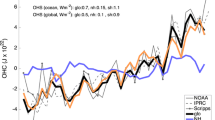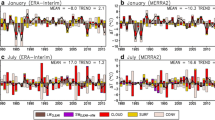Abstract
The reduction of solar radiation arriving in the summer half of the years by 65° N has been found to be a consequence of decreased inclination of the rotation axis and increased meridional contrast in insolation, rather than a result of climate cooling. Thus, the astronomical climate theory involves a paradox related to the fact that the change in the meridional heat transfer due to a change in the inclination of the rotation axis is disregarded. In this context, the mechanism of the astronomical chronology of climatic events in the Pleistocene needs to be revised.











Similar content being viewed by others
REFERENCES
Adhémar, J.A., Révolutions de la mer, déluges périodiques, Paris: Carilian-Goeury et V. Dalmont, 1842.
Aseev, A.A., Drevnie materikovye oledeneniya Evropy (Ancient Continental Freezes of Europe), Moscow: Nauka, 1974.
Berger, A., Support for the astronomical theory of climatic change, Nature, 1977, vol. 268, pp. 44–45.
Berger, A., Long-term variations of daily insolation and quaternary climatic changes, J. Atmos. Sci., 1978, vol. 35, no. 12, pp. 2362–2367.
Berger, A. and Loutre, M.F., Astronomical solutions for paleoclimate studies over the last 3 million years, Earth Planet. Sci. Lett., 1992, vol. 111, pp. 369–382.
Bertrand, C., Loutre, M.F., and Berger, A., High frequency variations of the Earth’s orbital parameters and climate change, Geophys. Res. Lett., 2002, vol. 29, no. 18, pp. 40-1–40-3. https://doi.org/10.1029/2002GL015622
Bol’shakov, V.A. and Kapitsa, A.P., Lessons of the development of the orbital theory of paleoclimate, Herald Russ. Acad. Sci., 2011, vol. 81, no. 4, pp. 387–396.
Brouwer, D. and Van Woerkom, A.J.J., The secular variation of the orbital elements of the principal planets, Astr-on. Pap., 1950, vol. 13, pp. 81–107.
Chetvertichnyi period v SShA (The Quaternary of the U.S.), Wright, H.E. and Frey, D.G., Eds., New Jersey: Princeton University Press, 1965; Moscow: Mir, 1968, vol. 1.
Cionco, R.G. and Soon, W.W.-H., Short-term orbital forcing: A quasi-review and a reappraisal of realistic boundary conditions for climate modeling, Earth Sci. Rev., 2017, vol. 166, pp. 206–222.
Croll, J., Climate and Time in Their Geological Relations: A Theory of Secular Changes of the Earth’s Climate, London: Edward Stanford, 1875.
Fedorov, V.M., Interannual variations in the duration of the tropical year, Dokl. Earth Sci., 2013, vol. 451, no. 1, pp. 750–753. https://doi.org/10.1134/S1028334X13070015
Fedorov, V.M., Spatial and temporal variations in solar climate of the Earth in the present epoch, Izv., Atmos. Ocean. Phys., 2015, vol. 51, no. 8, pp. 779–791.
Fedorov, V.M., Theoretical calculation of the interannual variability of the Earth’s insolation with daily resolution, Sol. Syst. Res., 2016, vol. 50, no. 3, pp. 220–224. https://doi.org/10.1134/S0038094616030011
Fedorov, V.M., Insolyatsiya Zemli i sovremennye izmeneniya klimata (The Earth’s Insolation and Modern Climate Changes), Moscow: Fizmatlit, 2018.
Fedorov, V.M., Earth’s insolation variation and its incorporation into physical and mathematical climate models, Phys.-Usp., 2019, vol. 62, no. 1, pp. 32–45.
Fedorov, V.M. and Frolov, D.M., Spatial and temporal variability of solar radiation arriving at the top of the atmosphere, Cosmic Res., 2019, vol. 57, no. 3, pp. 156–162.
Flammarion, C., Astronomie populaire, Paris, 1880; St. Petersburg: SPb. elektropechatnya, 1902.
Humboldt, A., Kosmos. Entwurf einer physischen Weltbeschreibung, Stuttgart: Cotta, 1845; Moscow: Brat’ya Salaevy, 1866. http://planet.iitp.ru/Oper_pr/tc_data/tc_ data_1.htm. http://www.cru.uea.ac.uk/cru/data/temperature.
Imbrie, J., Astronomical theory of the Pleistocene ice ages brief historical review, Icarus, 1982, vol. 50, pp. 408–422.
Imbrie, J. and Imbrie, K.P., Ice Ages (Solving the Mystery), Moscow: Progress, 1988.
Khromov, S.P. and Petrosyants, M.A., Meteorologiya i klimatologiya (Meteorology and Climatology), Moscow: MGU, 2006.
Kotlyakov, V.M. and Sonechkin, D.M., Modern interpretation of the history of interglacial ages of the Pleistocene, Led Sneg, 2015, no. 2, pp 103–122.
Köppen, W. and Wegener, A., Die Klimate der geologischen Vorzeit, Berlin: Gerb. Bornetraeger, 1924.
Lorenz, E.N., The Nature and Theory of the General Circulation of the Atmosphere, Geneva: WMO, 1967; Leningrad: Gidrometeoizdat, 1970.
Markov, K.K., Paleogeografiya (Paleogeography), Moscow: MGU, 1960.
Markov, K.K., Lazukov, G.I., and Nikolaev, V.A., Chetvertichnyi period (The Quaternary Period), Moscow: MGU, 1965, vol. 1.
Mel’nikov, V.P. and Smul’skii, I.I., Astronomicheskaya teoriya lednikovykh periodov: Novye priblizheniya. Reshennye i nereshennye problemy (Astronomical Theory of Glacial Ages: New Approximations. Solved and Unsolved Problmems), Novosibirsk.: GEO, 2009.
Milankovitch, M., Mathematische Klimalehre und astronomische Theorie der Klimaschwankungen, Berlin: Borntraeger, 1930; Moscow–Leningrad: GONTI, 1939.
Monin, A.S., Vvedenie v teoriyu klimata (Introduction to the Climate Theory), Leningrad: Gidrometeoizdat, 1982.
Monin, A.S. and Shishkov, Yu.A., Climate as a problem of physics, Phys.-Usp., 2000, vol. 43, no. 4, pp. 381–406.
Palmen E. and Newton, C.W., Atmospheric Circulation Systems, New York: Academic, 1969; Leningrad: Gidrometeoizdat, 1973.
Pilgrim, L., Versuch einer rechneriche Behandlung der Eiszeit, Jahreshefte des Vereins fur vaterlandische Naturkunde in Wurttemberg, 1904, vol. 60.
Pogosyan, Kh.P., Tsiklony (Cyclones), Leningrad: Gidrometeoizdat, 1976.
Sharaf, Sh.G. and Budnikova, N.A., Secular changes in the Earth’s orbit and the astronomical theory of climate fluctuations, Tr. Inst. Teor. Astron. Akad. Nauk SSSR, 1969, no. 14, pp. 48–84.
Vernekar, A., Long-Period Global Variations of Incoming Solar Radiation, Am. Meteorol. Soc., 1972.
Author information
Authors and Affiliations
Corresponding author
Ethics declarations
The authors state that there is no conflict of interests.
Additional information
Translated by V. Arutyunyan
Rights and permissions
About this article
Cite this article
Fedorov, V.M. The Problem of Meridional Heat Transport in the Astronomical Climate Theory. Izv. Atmos. Ocean. Phys. 55, 1572–1583 (2019). https://doi.org/10.1134/S0001433819100025
Published:
Issue Date:
DOI: https://doi.org/10.1134/S0001433819100025




